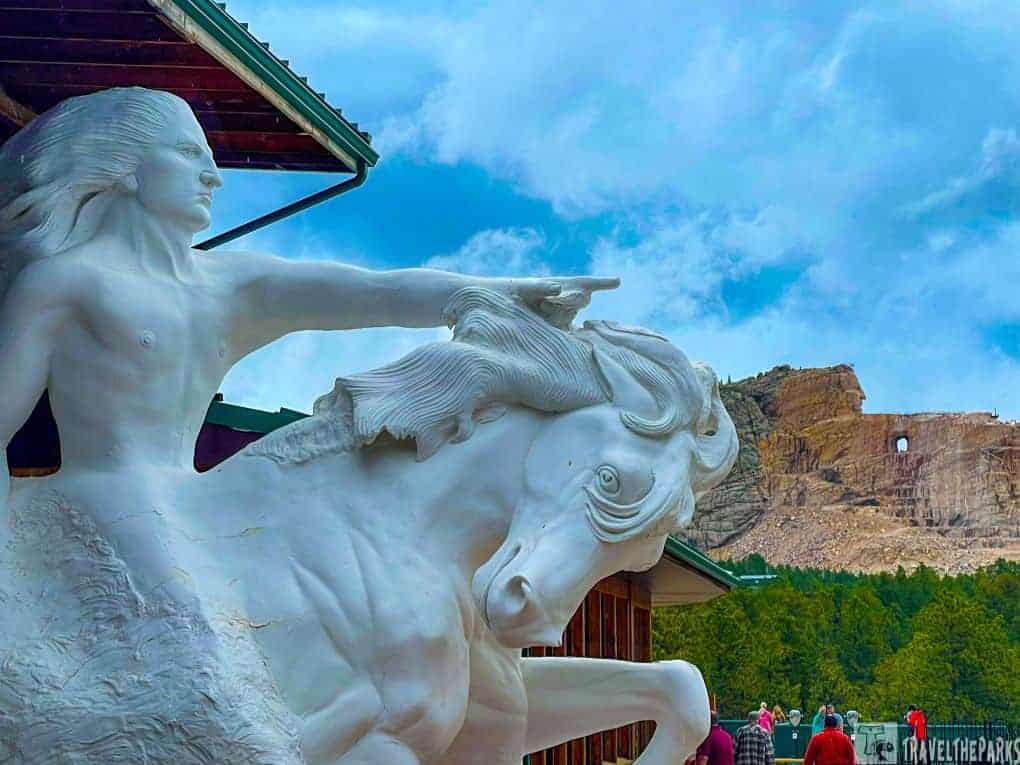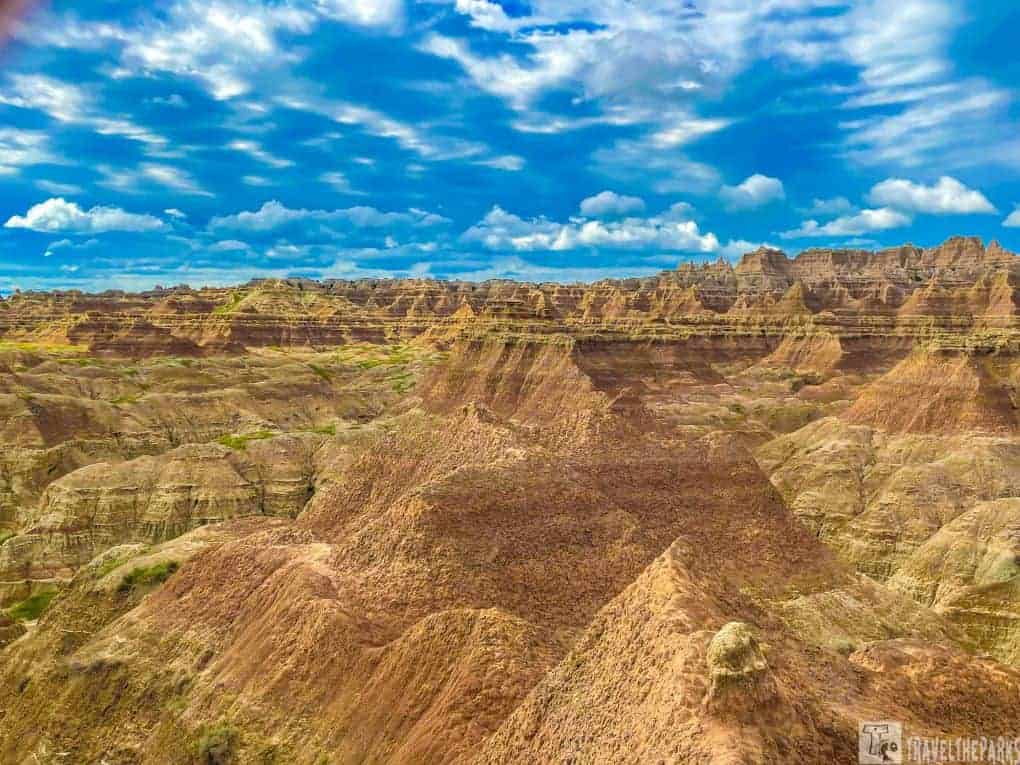Who doesn’t love Custer State Park? Named after Lt. Colonel George Armstrong Custer, it covers an area of 71,000 acres in the Black Hills, making it one of the nation’s largest state parks established in 1919. The oldest state park it is near Rapid City, South Dakota, and it is a convenient location to stay and visit Mount Rushmore National Monument, Wind Cave National Park, Crazy Horse Monument, Jewel Cave National Monument, and the towns of Spearfish, Deadwood, or Sturgis. Within the Custer State Park, there are a plethora of sights to see and do. Besides being home to bountiful wildlife, most travelers enjoy the many outdoor recreational activities such as camping, hiking, biking, swimming, fishing and boating.
This post may contain affiliate links, meaning if you purchase something through one of these links, we may earn a small commission at no extra cost to you! Read the full disclosure policy here.
Table of Contents
Getting to the Must-See Spots in Custer State Park
What a tremendous destination for a family road trip. This park is easily accessible by road from Rapid City. Head south on US-16 W/Mt Rushmore Rd. for 18-miles. From Keystone travel 16-miles south on the Peter Norbeck Byway-US Hwy. 16A south to the park.
From the town of Custer, follow US Hwy. 16 east for 15 miles to the West entrance station. From Hill City, it’s 28-miles on US Hwy-87 southeast to the Sylvan Lake entrance station. If you are coming from Hot Springs or Wind Cave National Park, take US Hwy. 87 north to reach the Blue Bell entrance station.
NOTE: We suggest bringing maps or a GPS device – cell service is limited in parts of the park. Download a map from the Custer State Park website before your visit.

Custer State Park has 5 entrances:
- East Entrance at the junction of the Iron Mountain Highway
- Blue Bell Entrance is the closest to Jewel Cave National Park.
- West Entrance is near the small town of Custer
- Sylvan Lake Entrance is convenient to Mount Rushmore, near Crazy Horse Memorial and the beginning of the Needles Highway.
- Wilson’s Corner Entrance is closest to the south end of the Needles Highway.

Important to Know Before You Go to Custer State Park
- Park Hours: Custer State Park is open year-round, 24 hours a day. Some areas (such as visitor centers) may have seasonal hours, typically from 8:00 AM to 5:00 PM.
- Entrance Fees: Private vehicle: $20 for a 7-day pass good at all South Dakota State Parks. Motorcycle: $10 for a 7-day pass. Annual pass: $36 for a full year of access. They provide an area map and a window sticker at the entrance station.
- Visitor Centers: Custer State Park Visitor Center: Near the park entrance, this center offers maps, brochures, and information about the park’s wildlife and history. The Peter Norbeck Visitor Center, in the northern part of the park, near the Needles Highway. It provides information on hiking, wildlife, and scenic drives. State Game Lodge: A historic lodge with more information about the park and its history.
- Pets: The park allows pets in certain areas, including campgrounds, on paved roads, and in parking lots. However, they must be kept at all times on a leash (6-foot maximum). Hiking trails, the backcountry, and most public buildings prohibit pets.
- Best Time to Visit: Summer (June–August): Ideal for outdoor activities, though it can be crowded, and temperatures are warmer. Fall (September–October): Great for avoiding the summer crowds and enjoying cooler weather and beautiful autumn colors. Spring (April–May): A wonderful time to see wildlife, particularly baby animals, but the weather can still be unpredictable. Winter (November–March): low crowd levels, perfect for those who enjoy winter scenery and solitude. Some roads may be closed because of the snow.

1. Must-See Spot in Custer State Park: Hit Just One of the Visitor’s Centers
- There are 3 different centers to tour:
- The Custer State Park Visitor Center at the intersection of Wildlife Loop Road and Hwy 16 is open 8am–6pm in summer, and 8am–4.30pm daily in the winter months, weather permitting.
- Peter Norbeck Outdoor Education Center–midway point on Hwy 16 near the State Game Lodge. They listed the Peter Norbeck Center on the National Register of Historic Places.
- Wildlife Station Visitor Center–on the north end of the Wildlife Loop Road.
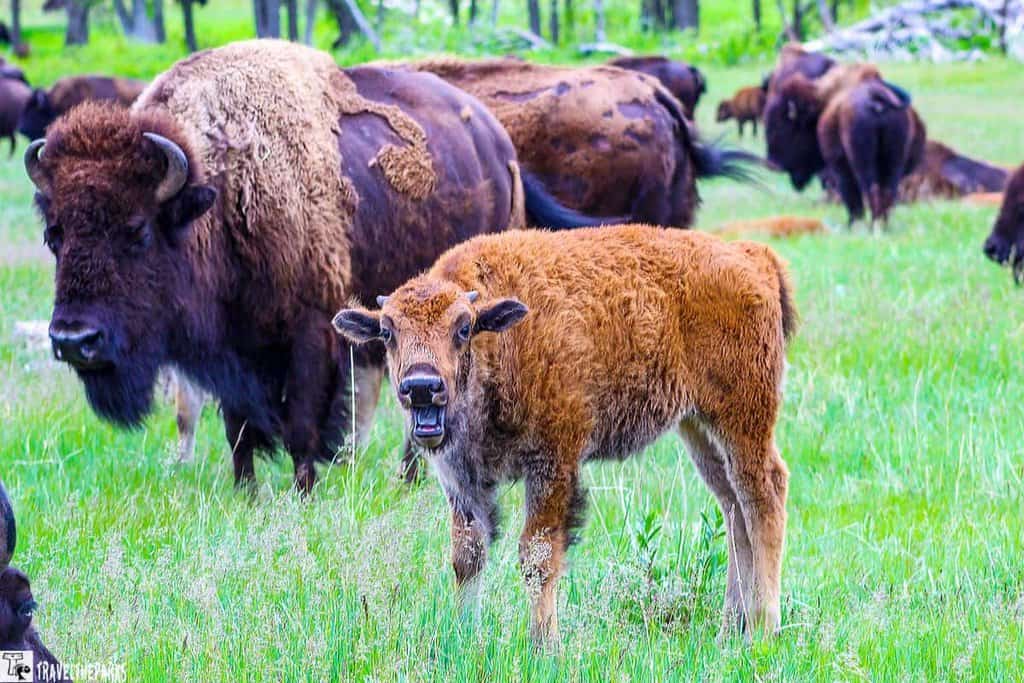
2. Drive the Unbelievable Custer State Park Wildlife Loop Road
We absolutely loved driving the Wildlife Loop. The 18-mile wildlife loop traverses through diverse habitats, including rolling grasslands, open prairie with clear running lakes and streams, and forested granite hills. Leaving Wind Cave National Park on US Hwy-87, we entered the wildlife loop at the Blue Bell entrance. The natural beauty of this place was noticeable from the moment we started on the loop road, with wildlife sightings right away. Our first encounter was a lone pronghorn antelope grazing just past the intersection of the 4-Mile Draw. To avoid oncoming traffic, we pulled off the road, and the pronghorn continued browsing, completely oblivious to the car. It was a perfect photo opportunity.

Driving the loop road, one sees that the landscape is constantly shifting. One moment, you’re passing rocky granite mountains blanketed in dense pine forests. Next, you find yourself beside clear mountain lakes and streams framed by lush grasslands.
Important Tip: The park’s roads should be driven with caution during the evenings and early mornings when visibility is low. Bison and other wildlife are extremely hard to see under these conditions.

#3-Run Wild, Run Free-Wildlife in Custer State Park
Definitely a lot of bison in Custer State Park. They are the largest animals in North America. They are truly something to see. The current herd in the park numbers about 1,500 head. A couple of times we even had to stop the car because the buffalo were walking across or standing on the road.
Bison calves are sometimes called “red dogs”. In the spring, the bison females separate from the males. We found a few groups of females and calves along the wildlife loop.

When is the best time to see wildlife?
Early mornings and early evenings are best for wildlife viewing. In the summer, venturing out onto some of the maintained gravel roads may improve your chances of spotting more wildlife. It is also a good way to avoid the more crowded areas of the park. We recommend a stop at the Wildlife Station Visitor Center. The rangers here always know the best spots to find wildlife. The weather was quickly turning as we headed towards the Custer Visitor Center. Earlier in the week, we had a terrible experience with hail. Luckily, today it’s just a passing shower.

Who Does not Like Prairie Dogs?
There are numerous spots along the loop to see prairie dog towns. Prairie dogs are entertaining. I could watch them all day. To ensure safety, prairie dog colonies work together in family groups. One or more individuals keep watch over the burrows while the rest of the group forages and maintains the dens. When a predator nears, the sentinel guards let out a loud alarm, signaling the group to quickly retreat into the safety of their burrow. The many interconnected tunnels protect the many family units.

4. One of the Best Things to See in Custer Park: Infamous Begging Burros
They used the burros centuries ago as pack animals to transport visitors to the top of Black Elk Peak. Today in the park, you can find the descendants of the burros that were originally released into the wild. They have roamed Custer State Park for nearly a century. Despite abandonment, the feral herd has survived. The Custer Wildlife Loop is a popular place to see them. A stop at any of the visitor centers will provide info on finding where the burros are on any given day.
It was the highlight of our drive to see these much sought after animals. These particular burros are known for peeking their heads into cars looking for snacks, as they are extremely friendly. Treat them with carrots or apples – they are gentle and look forward to the treat. I purchased a bag of carrots just for this purpose. Although it is prohibited to feed all other wildlife, conservation officers do not frown on feeding the burros.

#5-What to See in Custer State Park: The Peter Norbert Scenic Byway is not to be Missed!
Needles Highway, Iron Mountain Road, Highway SD-89, and Highway SD-244 make up the 68-mile Peter Norbeck Scenic Byway. Recognized as a National Scenic Byway, it offers never-ending views that will take your breath away. The work was the vision of US Senator Peter Norbeck, who was born in the Dakota Territory. They completed the construction in 1922. Norbeck’s legacy highway was named in his honor on September 23, 1996. His tireless efforts helped lead to the creation of the Badlands, Custer State Park and Mount Rushmore. They said he was “an ordinary man with an extraordinary vision.”
IMPORTANT Note: If you have a camper, RV or an oversized vehicle, verify that you are able to pass through the tunnels prior to driving the byways.

#6-Hidden gems to explore in Custer State Park: Drive the Stunning Needles Scenic Highway
There are not enough words to describe the beauty of Needles Highway in Custer State Park. The scenic highway, is14-miles from end to end, follows SD-87. It gets its name from the many needle-like granite formations that seem to reach into the endless sky. They completed it in 1922, no easy feat. After visiting Mount Rushmore, we ventured onto SD-87 from Hwy 16/Hwy 385, heading to Sylvan Lake. Driving along the Needles Highway with the explicit intent of taking advantage of the natural beauty of the Black Hills.

The speed limit is 25 mph, so we gave ourselves a couple of hours. We easily navigated the first section of the road through the lowland aspen forest. The leaves were just flushing. All around us, everything looked lush and green. We took a brief snack break at mile marker 8 and wandered along a small creek, hoping to spot some trout.

Continuing our journey, the scenic highway twisted through hairpin turns and quickly climbed in elevation. The needle-like spires became more frequent. The Hood Tunnel (8’9″ wide and 9’8″ high) is the first tunnel we entered. In total, you will encounter three tunnels along the Needles Highway. Interestingly, it took 150,000 pounds of dynamite and 2 years for the Civil Conservation Corps to complete the work. At the midpoint, we made a brief stop at Sylvan Lake to walk the trails.

NOTE: Because of the snow, the Needles Highway is closed in winter. You can usually drive on it between early April and mid-October.
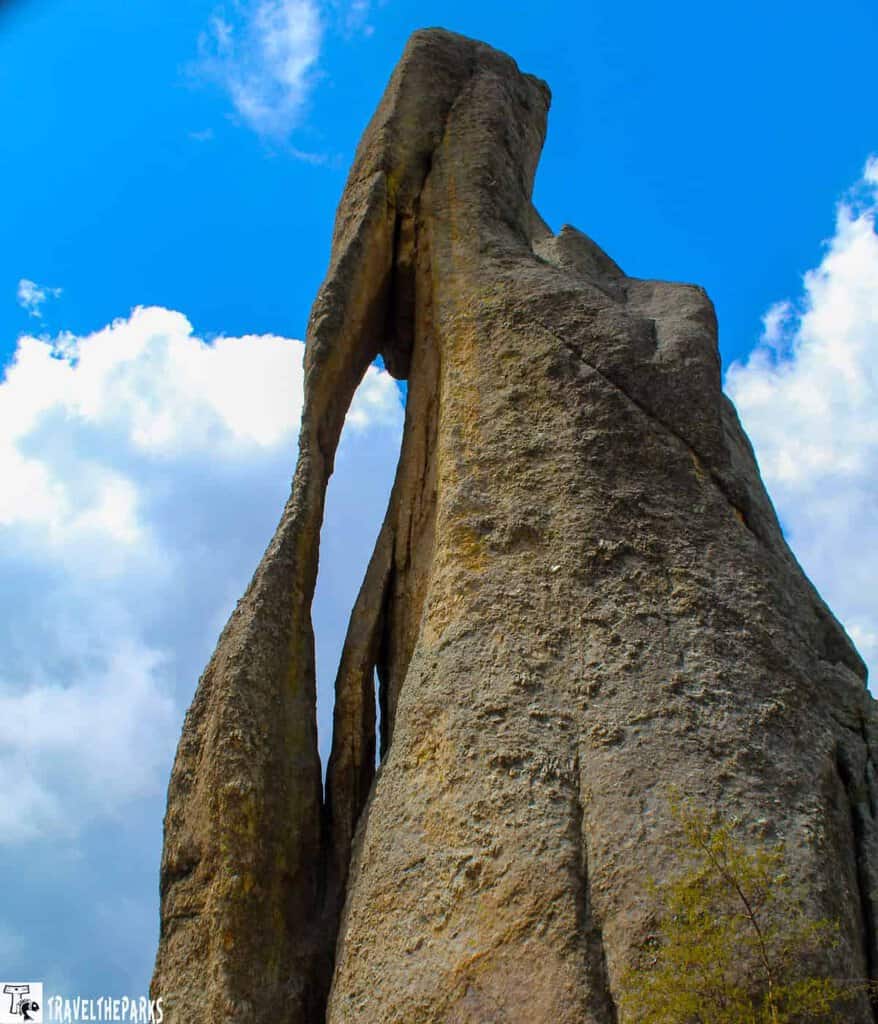
#7 Must-See Spot in Custer State Park: Threading the Needles Eye of Custer State Park
It is impossible to find a more dramatic tunnel along the road than the Needles Eye Tunnel. It feels as if you are perched atop the awe-inspiring granite spires. From the valley floor, the towering Black Hills tors rise in all directions. To appreciate the views, we pulled over to the small parking area just before the tunnel. People often spot mountain goats here, but today we didn’t see any.
The highlight is not just the tunnel, but also the signature “needle’s eye.” Wind and rain have carved this geological feature for millions of years. Here and throughout the park, rock climbing is allowed. We scrambled up the rock face to gain a better panoramic photograph. Returning to the car, we entered the tunnel. It truly is a feat of engineering.

#8-Awesome Ride on the Iron Mountain Scenic Byway
Under Governor Peter Norbeck’s direction, the Civilian Conservation Corps constructed the highway on the Iron Mountain Scenic Byway in the early 1930s. The 17-mile road connects Mount Rushmore National Memorial and the eastern entrance of Custer State Park. The road twists around 314 gut-wrenching curves, 14 hairpin bends/switchbacks, 3 tunnels and 3 pigtail bridges.

What are Pigtail Bridges?
What is a pigtail bridge? While developing Custer State Park, the South Dakota State Highway Commission built several bridges. According to locals, they named these bridges after the way cars first go straight over the top, then a 270-degree bend that descends and loops back under itself. After driving the first 3-miles, we came across our first Pigtail Bridge. In keeping with the park manager’s desire to blend into the natural setting, designers selected local pine for the construction of the pigtail bridges.

Iron Mountain Road also travels through three tunnels. They are in order from south to north: Scovel Johnson Tunnel (13’2″ wide, 12’4″ high), CC Gideon Tunnel (13’0″ wide, 11″0″ high), and the Doane Robinson Tunnel (13’2″ wide, 12’2″ high). The tunnels all offer extraordinary views, but one offers a sensational view of Mount Rushmore. Driving from the south towards the north, you can see Mount Rushmore splendidly framed in the distance.

#9-In Custer State Park Hiking Trails that Rock!
During any season, visitors can experience 450-miles of trails throughout the Black Hills National Forest. The trails in Custer traverse open prairies, rolling hills, and forested mountain slopes, showcasing stunning rock formations that frequently reveal breathtaking panoramic views.
What should we bring? Remember a good pair of sunglasses, sunscreen, towel, ball cap or wide-brimmed hat, and a light loose-fitting long-sleeved shirt for sun protection while on the trail. If you plan to walk the trails, bring bug spray for the biting insects and ticks.

All Trails Begin at Sylvan Lake in Custer State Park
There are so many excellent family-friendly hikes beginning at the lake that we loved exploring.
The lake sits at an elevation of over 6,100 feet. When a dam was constructed across Sunday Gulch Creek in 1881, this created the famous Sylvan Lake. The lake area features swimming, fishing, boating, and a large picnic area.

The Sylvan Lake Shore Loop Trail has amazing scenery. The hike was short and sweet. An easy 1-mile it can be accessed at different points. The trail snakes around massive granite boulders, through canyon gullies, up carved rock steps, and through picturesque tunnels. Check out the hidden rock from National Treasure 2 on this trail. Finding this rock is like a scavenger hunt, and great for kids. In the original film, it shows a secret lake behind Mount Rushmore. Surprisingly, it was actually shot at Sylvan Lake. It is easy to find, but I won’t give it away.
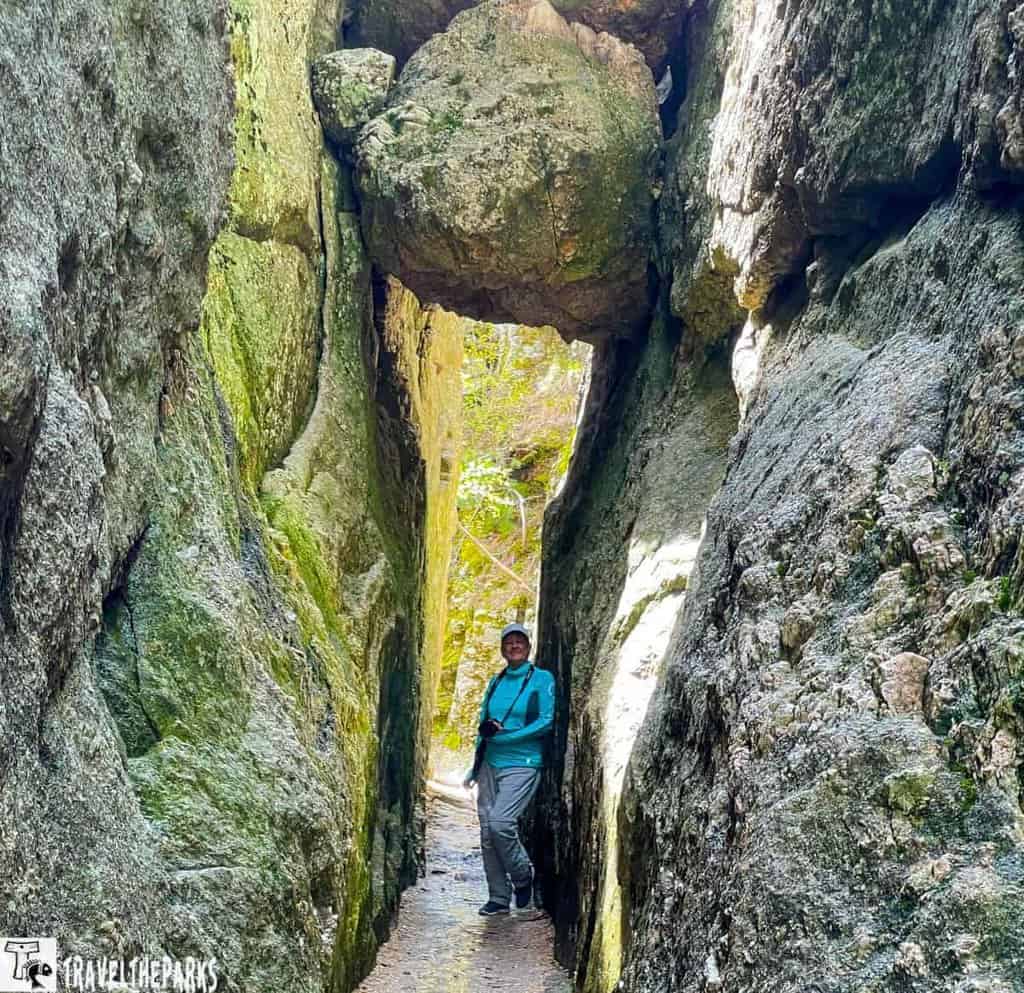
Sunday Gulch Trail is a 3.9-mile loop (Trail #6). The trailhead is behind the Sylvan Lake dam. We recommend doing the trail counterclockwise. Because the trail is strenuous, we opted to begin at the north trailhead. Right away, the trail descends through a boulder field. While handrails help with navigation, careful footing is still essential. The waterfall views are astounding in the early spring, with the winter runoff. The trail crisscrosses the creek a few times in the valley. For this reason, we recommend waterproof shoes or hiking boots on this hike. Bring plenty of water — at least 2 liters of water/per person. The remaining part of the trail steadily climbs back out of the valley. No matter what direction you choose on this trail, you have increased elevation. What goes down must eventually climb back up.
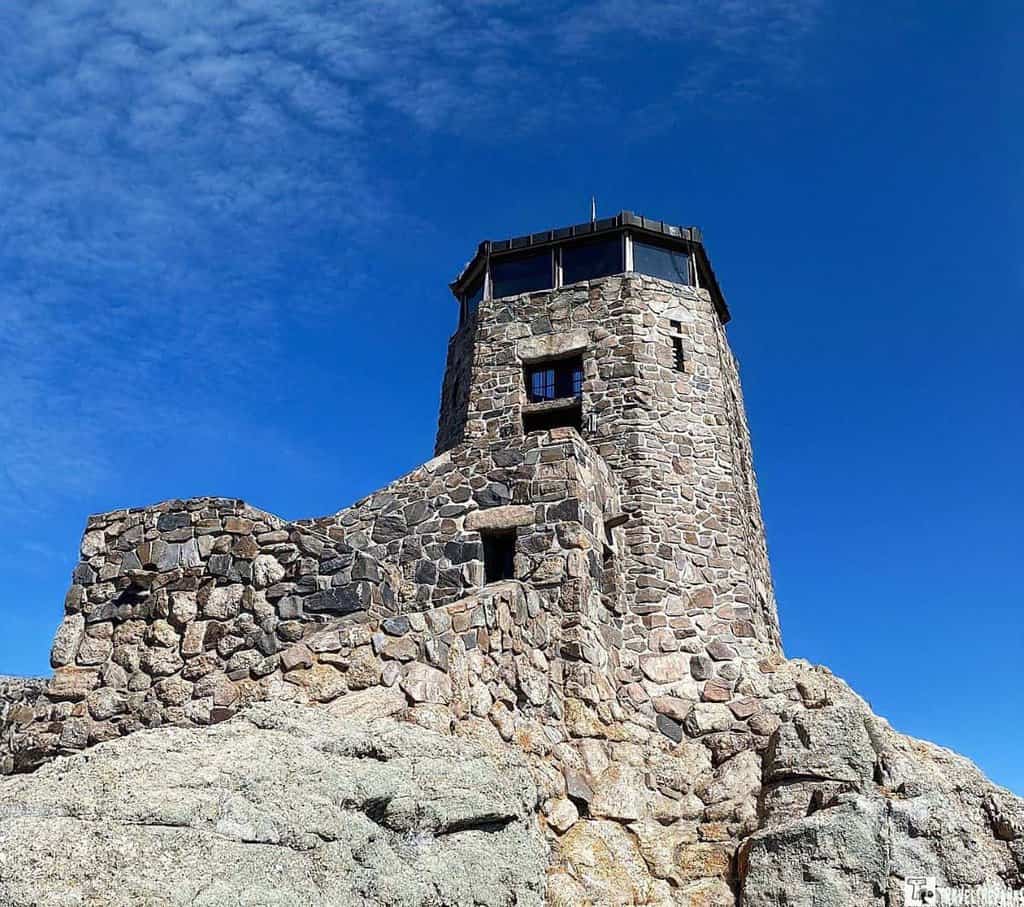
Mountain High: Black Elk Peak Trail
A 7.1-mile well-trafficked loop climbs to the top of the highest peak east of the Rockies at 7,242-feet. This is a pet-friendly trail. We began our early morning hike, crossing the footbridge at Sylvan Lake to Trail #9. The first part of the loop is 3.3 miles that steadily climbs, moving through meadows before entering the ponderosa pine-covered Black Hills. At the top of Black Elk Peak, the stone fire tower is impressive, but nothing beats the endless scenic vistas, regardless of which direction you look in the Black Hills. Built by the Civilian Conservation Corps in 1938 and decommissioned in 1967, the tower is the epic endpoint of the trail.

On the return, we took Trail #4 to complete the loop, adding an extra 3.5 miles. Along the way, we made side trips on the spur trails to both Poet’s Table and Little Devils Tower. Both detours are well worth it for the stunning views of Black Elk Peak. The short rock scrambles are moderately challenging, but the effort is more than rewarded by the breathtaking scenery.

Cathedral Spires Reaching the Horizon
This 1.6-mile out and back trail is not for the faint of heart. The moderately challenging trail climbs steadily in elevation. Beginning on the Needles Highway, it requires navigating a few large boulders as you climb towards the top. However, it is so worth it to see the towering granite spires greeting you at the end of the trail. It was here that we were delighted to see a lone mountain goat browsing the grasses between rock outcroppings. He seemed to take us in stride, paying us no mind. We snapped a few photos before moving further along the trail.

Other noteworthy trails we hiked:
- Prairie Trail-Off the west side of the Wildlife Loop road, this 2.1-mile loop traverses through grassland meadows, rolling hills along a ridge. Lots of wildflowers in the early spring. Passes over the creek via small wooden bridges, some mud after heavy rains. Saw bison and prairie dogs.
- Lovers Leap Trail – At 4.2 miles, it loops through incomparable scenery. We found our trekking poles good in the loose rocks on the steeper inclines on the trail. The views at the Lovers’ Leap are spectacular. Nice walk at the end along the riparian area of the creek.
PRO Tip: Many of the trails expose hikers to poison ivy and the occasional prairie rattler. Be observant. Hike with caution.
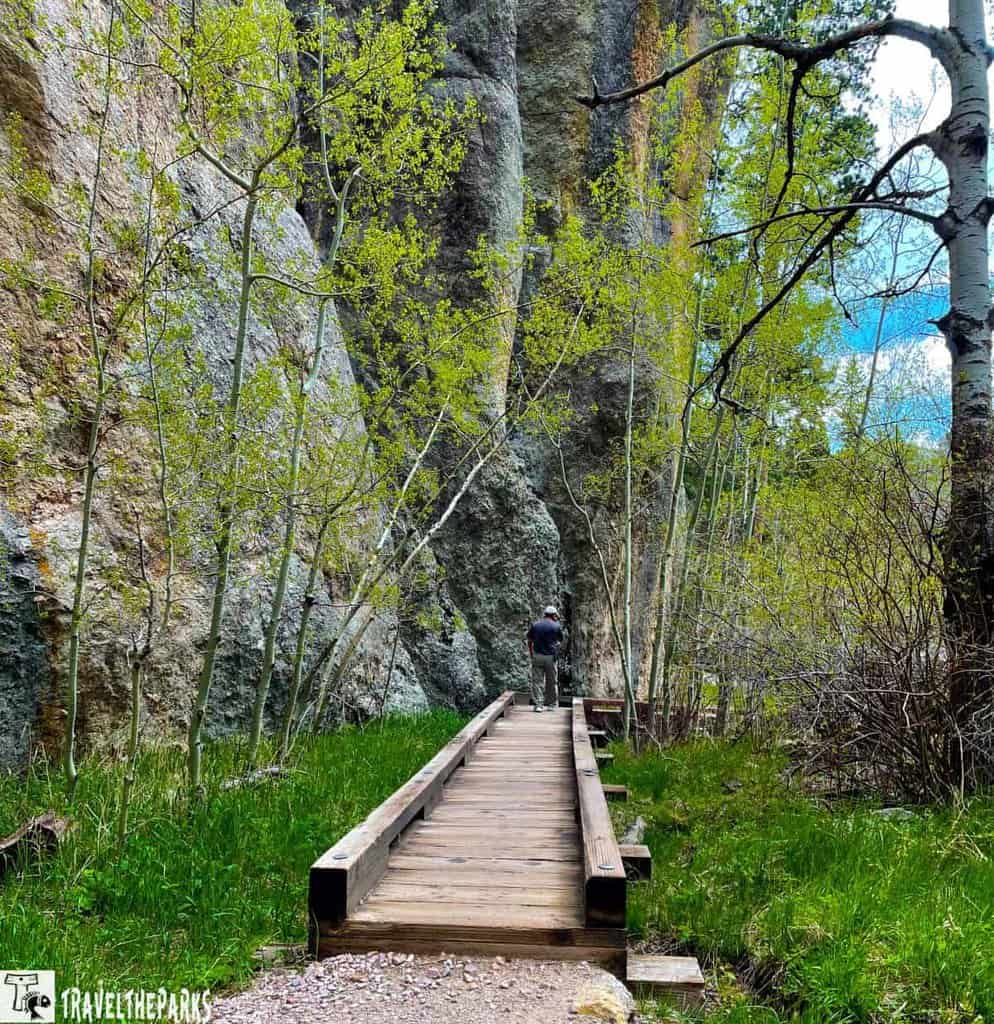
Best Things to See in Custer Park: Other Recreational Opportunities
This year-round destination is perfect for biking, rock climbing, horseback riding, camping, and more. Custer State Park is home to four incredible lakes: Sylvan Lake, Stockade Lake, Legion Lake, and Center Lake. Ideal for fishing. The Fish & Game department stocks them annually with brook, brown and rainbow trout. A valid South Dakota fishing license is required. Some lakes offer rentals of kayaks, canoes, and paddleboards. Swimming is a welcome relief in the hot summer months after hitting the trails. Winter activities include cross-country skiing and snowshoeing.

#10-Annual Buffalo Roundup Arts Festival in Custer State Park
Check out Custer State Park’s annual events, including the Buffalo Roundup Arts Festival, enjoyed during the Annual Buffalo Roundup. Held every year in late September, this is when the bison are corralled to be tested, vaccinated, and branded. Visitors can see the herd of 1,300 buffalo being rounded up at this popular local affair.
As part of the roundup, there is an annual arts festival and handicrafts sale, as well as live entertainment. When we visit again, I’ll be sure to plan our tour during this timeframe.

With the help of a $4 million grant from The Leona M. and Harry B. Helmsley Charitable Trust, the Bison Center was able to open in the summer of 2022. This new facility gives park visitors a complete history of the bison. The bison herd at Custer State Park takes center stage in interpretive displays aimed at teaching future generations about the significance of these iconic animals. The information about the 1,400-strong bison herd was both interesting and well presented.

Where to Stay in the Custer State Park
The park boasts four luxurious historic lodges with cabin facilities. Each lodge has dining options available. They are the State Game Lodge, Blue Bell Lodge, Legion Lake Lodge, and Sylvan Lake Lodge. There are also a variety of different campgrounds for RVs, travel trailers, tents and even horse lovers.
The State Game Lodge was the summer home of President Calvin Coolidge in 1927. Originally built in 1921, it was used to host commission meetings. Within a year, it burned to the ground, only to be rebuilt by 1922. Throughout the years, they have added sections to the lodge and renovated it many times. Today there are 7 historical rooms, 40 motel rooms, 31 cabins and a first-class dining room that serves local specialties (elk, pheasant, and bison). The State Game Lodge Restaurant is open for breakfast, lunch, and dinner.

The woodsy aesthetic Sylvan Lake Lodge sits on the edge of picturesque Sylvan Lake. Its natural beauty makes this the crown jewel of the park. They built the original stone and wood lodge in 1937. In 1991, they added a new wing of lodge rooms to the lodge. Last year (2021) fire damaged part of this section of the lodge. Currently, all 35 rooms are closed at the lodge. Renovations are in process with the opening expected in 2023. Sleeping cabins, honeymoon cabins, and housekeeping cabins are among the 32 cabins on the pine- and spruce-covered hillside. With five bedrooms, a full kitchen, and ten beds, the Senator’s cabin easily accommodates a larger group. Close to the most popular hiking trails.

Other Lodges in Custer State Park
Legion Lake Lodge on the beach, with access to fishing and kayaking, this lodge is the perfect place for soaking up some sun. You can rock climb, hike/bike, row/canoe, and enjoy many other outdoor activities onsite. Lakeside patio dining with excellent water views is available. There are 26 sleeping cabins, housekeeping cabins, or the larger two-story Centennial Cabin in a wooded setting.
Blue Bell Lodge invokes a Wild West cowboy feeling. There are 29 rustic log sleeping cabins, a honeymoon cabin, and housekeeping cabins. A full-service restaurant and a small general store within walking distance of the cabins and nearby campground. They offer Trail Rides and Nightly Wildlife Tour Hayride & Chuckwagon Cookouts during summer. Great stay for families.
Creekside Lodge, the newest lodge built in 2008, is close to the amenities offered by the State Game Lodge. Open year-round, the 30 lodge rooms are deluxe accommodations. An excellent location, easy access to the wildlife loop road, needles highway, iron mountain and hiking trails.

Campgrounds in Custer State Park
Currently, Custer State Park has 9 campgrounds with 341 campsites. The park is quite large, and the choice of a site depends on what you as a camper prefer. We highly recommend making campground reservations. Each campsite has a gravel or paved camping pad, picnic table, fire ring and grill.
Grace Coolidge Campground-Highway 16A, about 2 miles west of the Custer State Park Visitor Center. Centrally located, it’s a quiet spot in a more laid-back area of the park. Clean restrooms, flush toilets and free showers with plenty of warm water. Cell service was nonexistent. If you enjoy fishing, the Grace Coolidge Creek is accessible via a 5.4-mile trail. Easy access to the Needles Highway.

Game Lodge Campground-Closer to the action, it is within easy access to the main lodge, general store, wildlife loop road and visitors’ center. The campground is quiet and clean. Well maintained, it has flush toilets and showers. The sites are closer together. However, there is ample shade, and some sites are along the pond. There is also a dump station in the campground, potable water fill-up, and most sites have electricity.

Blue Bell Campground is in the southern portion of the park along Highway 87. The 30 sites are open seasonally from May to mid-October. You can enjoy western-style cookouts and hayrides at the campground, which is conveniently located near a restaurant and general store. Sites are rather open with little privacy.
Additional campgrounds are at Legion Lake, Center Lake, Sylvan Lake, French Creek Horse Camp and Stockade Lake-North and South. Most are open annually from May to mid-October. While some sites provide electric hookups, all campers have access to clean restrooms and shower facilities.

Final Thoughts: 10 Amazing Places to Visit in Custer State Park
Custer State Park has been on our bucket list for a long time, and it did not disappoint! A dramatic and stunning place to visit, Custer State Park was indeed a memorable journey in South Dakota. It is one of those places that everyone should see at least once in their lifetime. You’ll discover a world of adventure!
Have you been to the Custer State Park? Did you do any hiking? Which ones? What did you like (or not like) about it?


